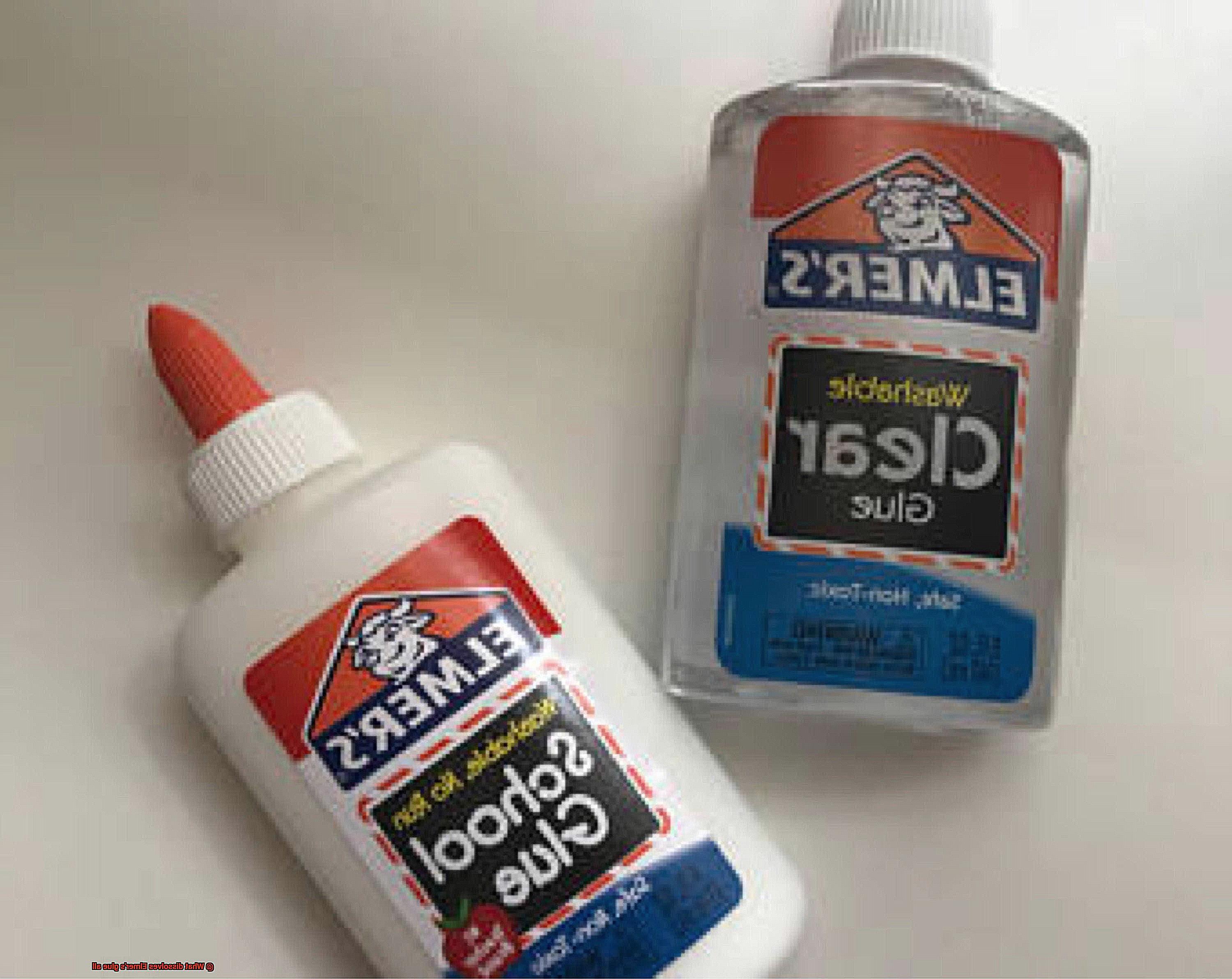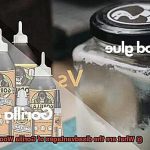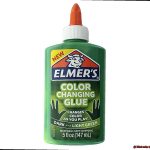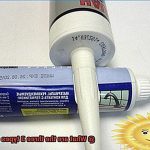Are you tired of struggling to remove stubborn glue stains or dried glue splatters from your crafting projects? Fear not, my fellow DIY enthusiast. In this post, we’ll delve into the fascinating world of Elmer’s glue all and its dissolving agents.
If you’ve ever worked with craft glue, particularly the popular Elmer’s glue all, then you know how frustrating it can be to remove its sticky residue once it dries. But don’t worry – there are several effective and accessible ways to dissolve Elmer’s glue all. From vinegar and soap to rubbing alcohol, we’ll explore the most common and efficient substances that can tackle this pesky problem.
Not only will these solvents break down dried glue, but they can also make your life easier in various ways. You can use them to clean your tools and supplies or even remove glue residue from fabrics and other materials.
So whether you’re a seasoned crafter or just looking for some helpful hacks to simplify your DIY projects, keep reading to discover what dissolves Elmer’s glue all and how you can use it in your everyday life.
What is Elmer’s Glue All?
Contents
- 1 What is Elmer’s Glue All?
- 2 Benefits of Elmer’s Glue All
- 3 Challenges with Removing Elmer’s Glue All
- 4 Warm Water and Soap Method for Removing Elmer’s Glue All
- 5 Vinegar Method for Removing Elmer’s Glue All
- 6 Rubbing Alcohol Method for Removing Elmer’s Glue All
- 7 Acetone Method for Removing Elmer’s Glue All
- 8 Safety Precautions When Using Acetone to Remove Elmer’s Glue All
- 9 Conclusion
Produced by the trusted Elmer’s Products company, this white, water-based glue is a go-to for bonding materials such as paper, cardboard, wood, fabric, and even some plastics.
What makes Elmer’s Glue All so effective? Its secret lies in its combination of polyvinyl acetate (PVA) and water. PVA is a synthetic polymer known for its strength, flexibility, and ability to resist water and chemicals. This winning formula results in an adhesive that dries clear and can be sanded or painted over once it has cured.
But the benefits of Elmer’s Glue All don’t stop there. This non-toxic glue is safe for children to use and easily washable with soap and water. Its popularity can be attributed to its ease of use, strong bonding capabilities, and non-toxic nature.
And what if you accidentally get Elmer’s Glue All in an unwanted area? Fear not – there are several substances that can dissolve the glue, including warm water and soap, vinegar, rubbing alcohol, and acetone. Just be sure to choose the right solvent for the surface you’re working on and follow safety precautions when using chemicals like acetone.
Benefits of Elmer’s Glue All
Look no further than Elmer’s Glue All – a versatile and reliable glue that has been trusted for decades. As an expert on this topic, I can tell you that Elmer’s Glue All offers a multitude of benefits that make it a go-to for many people.
Firstly, one of the key benefits of Elmer’s Glue All is its versatility. It can be used on an array of surfaces, including paper, cardboard, wood, fabric, and more. This makes it a perfect choice for various applications such as crafting or DIY projects.
But that’s not all – Elmer’s Glue All also creates a strong bond that can withstand regular wear and tear, making it ideal for projects that require durability. Whether you’re creating a school project or repairing an item around the house, Elmer’s Glue All can provide the strength you need to get the job done right.
In addition to its strength and versatility, Elmer’s Glue All is also non-toxic and easy to clean up. This makes it a safe choice for children to use in their art projects, as well as a convenient option for adults who want to avoid harsh chemicals or difficult clean-up processes.
As if those benefits weren’t enough, Elmer’s Glue All dries clear and is perfect for both permanent and temporary bonding needs. You can use it to repair household items or to stick photos in your scrapbook without worrying about any unsightly residue.
Challenges with Removing Elmer’s Glue All
Elmer’s Glue All is a beloved adhesive for all kinds of crafting and DIY projects. But what happens when you need to remove it? Well, that’s when the challenges begin.
Firstly, Elmer’s Glue All is water-resistant, making it tricky to remove with just water alone. It’s no easy feat to break down this tough glue, especially when it comes to cleaning up spills or removing it from surfaces.
Secondly, Elmer’s Glue All dries quickly, meaning that if you don’t clean up a spill immediately, the glue can dry onto the surface. This makes it even harder to remove and can be particularly problematic when dealing with fabric materials like clothing.
Lastly, Elmer’s Glue All is a strong adhesive that can bond firmly to surfaces – which can make attempting to remove it without causing damage a bit of a challenge. Some people have reported damage to surfaces such as wood or paint while trying to remove it.
But don’t worry – we’re here to help. With the right techniques and tools, you can effectively remove Elmer’s Glue All without causing damage. Here are some of the best methods for dissolving Elmer’s Glue All and removing it from various surfaces:
- Rubbing alcohol: Apply rubbing alcohol to the glue and let it sit for a few minutes before wiping away with a cloth.
- Vinegar: Soak a cloth or paper towel in vinegar and apply it to the glue. Let sit for a few minutes before wiping away.
- Ammonia solution: Mix ammonia and water together and apply to the glue with a cloth. Let sit for a few minutes before wiping away.
- Heat: Use a hairdryer or heat gun to soften the glue before wiping it away.
Warm Water and Soap Method for Removing Elmer’s Glue All
Look no further than the warm water and soap method. This popular and safe technique is perfect for removing stubborn glue from fabrics, carpets, upholstery, and more.
Before you begin, gather your materials: a bowl of warm water, liquid soap, a clean cloth or sponge, and a scraper or spatula. Once you have everything ready, follow these steps:
Step 1: Soften the glue with warm water.
Pour warm water over the glue to soften it up and make it easier to remove.
Step 2: Apply soap and let it penetrate.
Gently apply liquid soap to the affected area using a cloth or sponge. Be sure to cover the entire area with soap and let it sit for a few minutes, allowing it to penetrate the glue.
Step 3: Remove the glue carefully.
Using a scraper or spatula, carefully remove the glue from the surface. Work slowly and gently to avoid damaging the surface. If any glue remains, repeat the process until all of it is removed.
Step 4: Rinse and dry thoroughly.
Rinse the area thoroughly with clean water and dry it with a clean towel or cloth. It’s important to ensure that all soap residue is removed as well to avoid any staining or damage.
Vinegar Method for Removing Elmer’s Glue All
If you’re struggling to remove stubborn Elmer’s Glue All from surfaces, the vinegar method might just be the solution you need. As an expert in this field, I am here to guide you through this simple and effective cleaning hack.
To get started, gather your supplies: white vinegar, a cloth or paper towel, and warm water. Begin by dampening the cloth or paper towel with warm water and gently wiping the affected area to remove any excess glue.
Now, it’s time to bring out the magic ingredient – vinegar. Pour a small amount onto the glue and let it sit for a few minutes. The acidic properties of vinegar break down the glue, making it easier to remove.
Once the vinegar has had time to work its magic, use the cloth or paper towel to gently scrub the area until the glue starts to come off. It might take a little elbow grease, but don’t worry – the end result will be worth it.
Repeat this step if necessary until all of the glue is removed. Finally, rinse the area thoroughly with warm water to remove any leftover vinegar or glue residue.
It is important to note that while vinegar is an effective solution for removing Elmer’s Glue All from most surfaces, it may not be suitable for all materials. Always test a small, inconspicuous area before using any cleaning solution on a larger surface.
Rubbing Alcohol Method for Removing Elmer’s Glue All
Rubbing alcohol is here to save the day. This popular method dissolves the glue and makes it easier to remove from surfaces.
Before we begin, let’s gather our supplies:
- Rubbing alcohol
- Clean cloth or sponge
- Warm water
Now, let’s dive into the steps for using the rubbing alcohol method to remove Elmer’s Glue All.
- Step 1: Apply a small amount of rubbing alcohol onto the glue stain and let it sit for a few minutes. The alcohol needs time to dissolve the glue and make it easier to remove.
- Step 2: Gently wipe away the glue with a clean cloth or sponge. If the glue is still being stubborn, pour more rubbing alcohol onto the stain and repeat the process until all of the glue has been removed.
- Step 3: Rinse the surface thoroughly with warm water to remove any residue from the rubbing alcohol.
It’s important to note that rubbing alcohol can damage some surfaces, so use it with caution. Test it in an inconspicuous area first to ensure it doesn’t cause any damage or discoloration.
The rubbing alcohol method is a quick and easy way to remove Elmer’s Glue All from surfaces. Say goodbye to those stubborn stains and hello to a fresh-looking surface.
Acetone Method for Removing Elmer’s Glue All

Look no further than the Acetone Method. Acetone is a powerful solvent that breaks down the glue bonds, making it easier to remove. However, it’s essential to handle acetone with care. This highly flammable substance can be harmful if inhaled or ingested, so make sure you wear gloves and keep it away from heat sources.
To use the Acetone Method, you’ll need acetone, a cotton swab or cloth, and warm soapy water. Begin by applying a small amount of acetone to the surface where the glue is located. Gently rub the glue with a cotton swab or cloth until it starts to dissolve. You’ll notice the glue breaking down quickly, making it easy to wipe away any excess with a clean cloth or paper towel.
If there’s still some residue left, repeat the process until all the glue has been removed. Afterward, clean the area thoroughly with warm soapy water and rinse with water. It’s essential to note that acetone should not be used on painted surfaces as it can cause the paint to peel off. Additionally, acetone can damage certain types of plastics, so test a small area before using it on a larger surface.
In summary, here are some key takeaways:
- The Acetone Method is an effective way of removing Elmer’s Glue All.
- Handle acetone with care, wear gloves and keep it away from heat sources.
- Gather your supplies: acetone, cotton swab or cloth, warm soapy water.
- Apply a small amount of acetone to the surface where the glue is located and gently rub until it starts to dissolve.
- Wipe away any excess with a clean cloth or paper towel.
- Repeat the process until all the glue has been removed.
- Clean the area thoroughly with warm soapy water and rinse with water.
- Test a small area before using acetone on painted surfaces or certain types of plastics.
Safety Precautions When Using Acetone to Remove Elmer’s Glue All
Acetone is a powerful chemical that can quickly break down the glue, but it’s essential to take necessary safety precautions to keep yourself and others safe.
Firstly, ensure you’re working in a well-ventilated area. Acetone produces harmful fumes that can be dangerous if inhaled in large amounts. So, open up windows or work outdoors if possible to maintain good air circulation.
Secondly, protect your skin and eyes by wearing gloves and eye goggles. Acetone can cause irritation or chemical burns on the skin, making it crucial to wear protective gloves. Eye goggles will also shield your eyes from any splashes or fumes.
Thirdly, never mix acetone with other chemicals as this can lead to dangerous reactions that release toxic fumes or cause fires. Always use acetone on its own and follow instructions carefully.
Lastly, dispose of all materials used when working with acetone properly. Gloves, rags, and other items that come into contact with the chemical should not be thrown in the trash as they are a fire hazard. Instead, dispose of them according to local hazardous waste guidelines.
e7P4KFmgIcM” >
Also Read: Is Elmer’s Glue Waterproof?
Conclusion
In conclusion, Elmer’s Glue All is a jack-of-all-trades adhesive that can tackle any crafting or DIY project. However, its stubborn residue can be quite the headache. Luckily, there are several effective and accessible methods to dissolve Elmer’s Glue All that won’t leave you pulling your hair out.
Warm water and soap are perfect for removing glue from fabrics, carpets, upholstery, and more. Vinegar is an all-purpose solution for most surfaces but may not be suitable for delicate materials. Rubbing alcohol is a quick and easy fix but should be used with caution as it can damage certain surfaces. Acetone is the heavy hitter of solvents – quickly breaking down glue bonds – but requires careful handling due to its highly flammable nature.
When using these solvents to remove glue residue, safety should always come first. Remember to wear gloves and eye goggles, work in a well-ventilated area, dispose of materials properly, and test on small areas before applying them to larger surfaces.
Knowing what dissolves Elmer’s Glue All can also make your life easier beyond just removing stubborn stains. These solvents can clean tools and supplies or remove glue residue from different materials.






